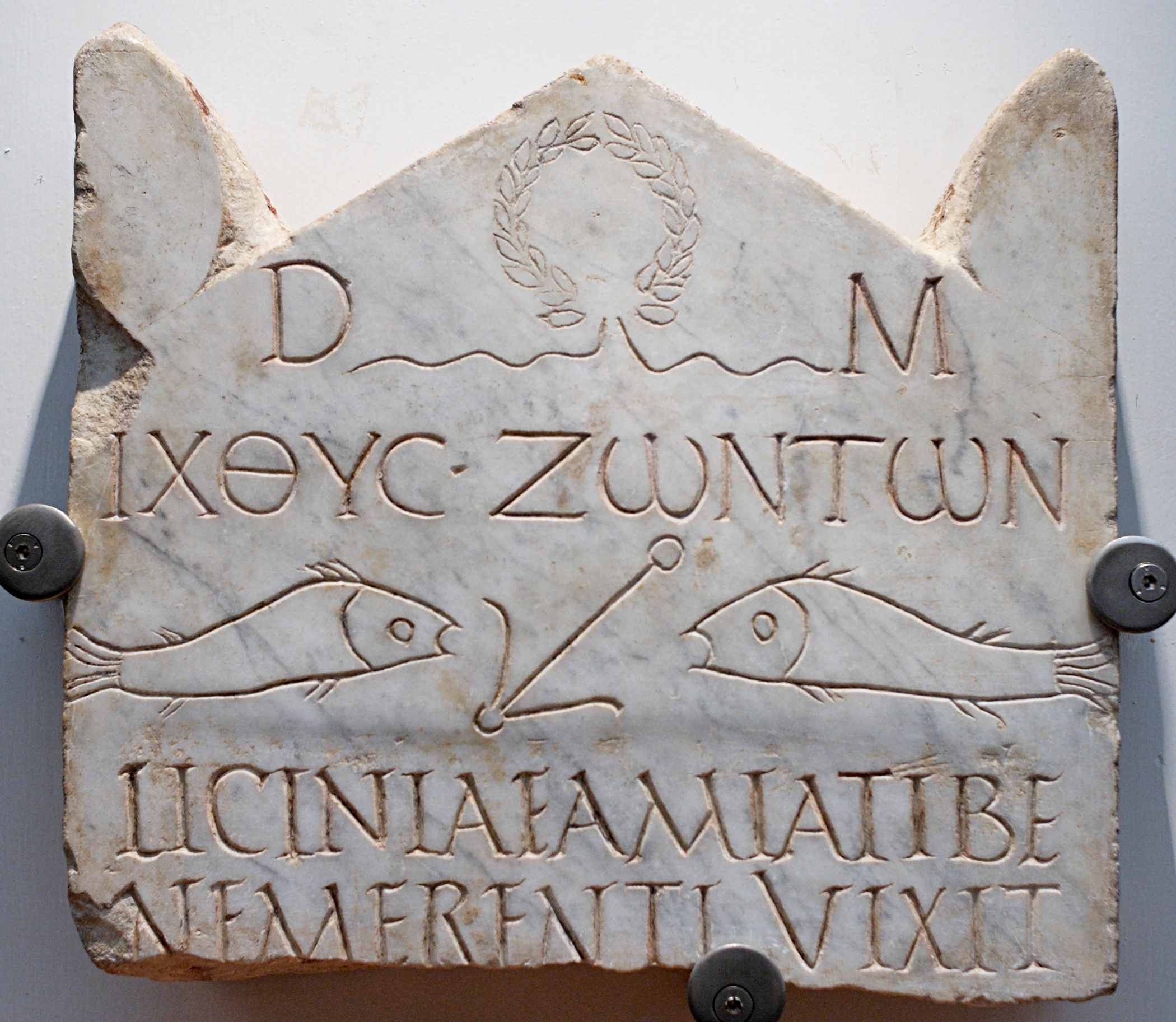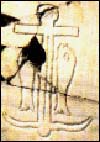
 |
Freethought & Rationalism ArchiveThe archives are read only. |
|
|||||||
|
|
Thread Tools | Search this Thread |
|
|
#1 |
|
Veteran Member
Join Date: Jun 2010
Location: seattle, wa
Posts: 9,337
|
 Funerary stele of Licinia Amias, one of the most ancient Christian inscriptions. Upper tier: dedication to the Dis Manibus and Christian motto in Greek letters ΙΧΘΥC ΖΩΝΤΩΝ / Ikhthus zōntōn ("fish of the living"); middle tier: depiction of fish and an anchor; lower tier: Latin inscription “LICINIAE AMIATI BE/NEMERENTI VIXIT”. Marble, early 3rd century CE. From the area of the Vatican necropolis, Rome. |
|
|
|
|
#2 |
|
Contributor
Join Date: Mar 2006
Location: Falls Creek, Oz.
Posts: 11,192
|
|
|
|
|
|
#3 |
|
Veteran Member
Join Date: Jun 2010
Location: seattle, wa
Posts: 9,337
|
Explain
|
|
|
|
|
#4 | |
|
Veteran Member
Join Date: Jul 2008
Location: Location: eastern North America
Posts: 1,468
|
These antiquities experts claim LATE, not early, third century.
Can someone explain HOW we know ANY date at all for this piece of marble? Quote:
A coin, minted, apparently, on instructions by Emperor Domitian, approximately at the end of the first century, CE or thereabouts.... Pete's coin reveals a somewhat similar view of a "fish", quite possibly a dolphin, together with an anchor, indicating, I imagine, that Pete disputes your apparent belief, (that fish symbols are somehow uniquely Christian,) by showing that similar imagery ("fish" plus anchor) was widespread in Greek culture, in the broader Mediterranean region, under Roman control, in the first few centuries, common era. avi |
|
|
|
|
|
#5 |
|
Veteran Member
Join Date: Jul 2008
Location: Location: eastern North America
Posts: 1,468
|
Can some learned person, not someone texting while driving a motor vehicle, explain to me, how "fish of the living",
ΙΧΘΥC ΖΩΝΤΩΝ relates to christianity? Thank you |
|
|
|
|
#6 |
|
Veteran Member
Join Date: Jun 2010
Location: seattle, wa
Posts: 9,337
|
Presumably the inscription is Catholic so the fish here is Jesus.
ΙΧΘΥC ΖΩΝΤΩΝ = θεος ζωντων (Mark 12.27). |
|
|
|
|
#7 |
|
Regular Member
Join Date: Jun 2008
Location: Australia
Posts: 412
|
|
|
|
|
|
#8 | |
|
Contributor
Join Date: Mar 2006
Location: Falls Creek, Oz.
Posts: 11,192
|
Provenanced from the area of the Vatican necropolis, Rome, the catacombs have been Catholic Church controlled territory for a while - at least since the late 4th century renovations of Damasius. The coin at post #2 , as avi pointed out, showing a fish and an anchor, does not logically establish that the Roman Emperor Domitian was a christian.
The Anchor Here is some background propaganda from the Catholic Encyclopaedia ... Quote:
This symbol is utterly ambiguous, and cannot be used to demonstrate "Early Christianity".  The above enlarged is listed as Plate 2 in Graydon Snyder's "Ante pacem: archaeological evidence of church life before Constantine". We are looking at an inscription the motif of which is the sea, boats, anchors and fishing. That such a motif represents evidence for "Early Christianity" is entirely misfounded. The Fish Snyder deals with the fish at Section 2.11 and remarks "One of the earliest witnesses for the fish would be the Epitaph of Abercius." However the symbol of the fish is utterly ambiguous and cannot be used to identify "early christianity". Next please ! Expected Evidence not found - Common Use of the "Nomina Sacra" Name for "Jesus" If the books of the Greek new testament were in production use during the 1st to the 3rd centuries as the current interpretation of the paleographers assert, then the physical form of these Greek books were highly conspicuous in comarison to other Greek books at that time. The special characteristic of the new testament books at this time, and universally, through to the late fourth century, was the consistent use of "nomina sacra". The coded name for the ultimate and powerful name of Jesus, the greatest name above all names, Ἰησοῦς was the nomina sacra form of ...... " ΙΣ ". This universal representation was not much to remember. It was two letters of the Greek alphabet - used to represent the name of Ἰησοῦς. To an illiterate Christian in antiquity, would not these two letters be "special"? If we forget about the nomina sacra used for "Joshua" in the "Christian LXX", these two letters for Jesus are unique. A very special combination of these two Greek letters, that could help to identify the emergence of a "distinctivel christian" products? Why do we not see this symbolic name of Jesus as " ΙΣ " on popular items or even graffitietc? I would expect large volumes of " ΙΣ " graffiti if people had contemplated the books of the new testament in consultation with their learned bishops and "readers from the pulpit". After all, the new testament books themselves were written like that. Any educated greek reading the book would need to ask the reader or the bishop what the coded form of " ΙΣ " actually meant. There is no legend provided. The almost universal use of the "nomina sacra" is still a mystery. I think it is also mysterious that the common people of the empire who were christians could not string two letters of the Greek alphabet together if their life depended upon it, to mimic the coded form of their beloved leader. |
|
|
|
|
|
#9 |
|
Veteran Member
Join Date: Jul 2008
Location: Location: eastern North America
Posts: 1,468
|
Mark 12:27
ouk estin qeoV nekrwn alla zwntwn polu planasqe What does a living fish have to do with a living god? I thought JC was supposed to be a fisher of men, not simply an icthus himself.... If the person who died, spent their entire adult life, perhaps even their childhood, fishing, why wouldn't that fact appear on their tombstone, irrespective of their philosophical or religious perspectives? I thought the title of this thread was "clear" evidence....It looks very unclear to me.... So, can anyone explain how a date of (either) early third or late third century, came to be assigned to this particular piece of stone? avi |
|
|
|
|
#10 |
|
Veteran Member
Join Date: Jun 2010
Location: seattle, wa
Posts: 9,337
|
Pete
Its always fun to enter the twilight zone. You found one guy who has a different take on the inscription than 99.9% of the other people who have ever published something on the object. Great! But so what? There's always a whack job who thinks he can argue the sky isn't blue. But what about the other 99.9%? They don't count? Erik con Daniken has published best selling books arguing that the Bible is about extra-terrestrials. I guess the history of Judeo-Christianity was "settled" the minute he published his theory too. |
|
|
| Thread Tools | Search this Thread |
|